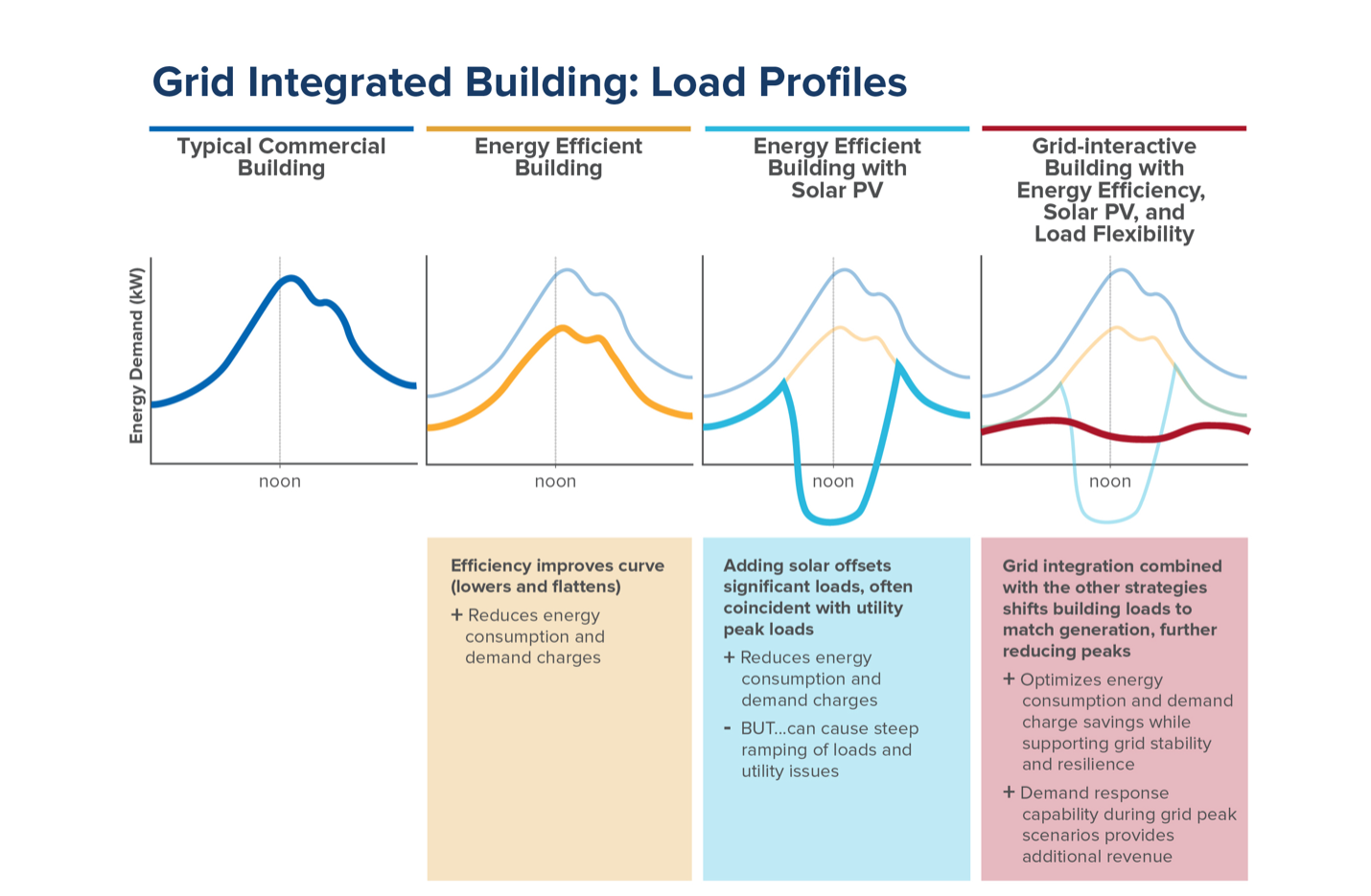air con maintenance engineer in empty office floor

Why Grid-Interactive Efficient Buildings Feature Prominently in Biden’s Plans
The White House on May 17 announced a slate of new programs aimed at integrating US buildings into the clean energy economy. The initiatives include electrification programs for existing homes, workforce training for next-generation jobs in the buildings sector, and efforts to increase the adoption of efficient electric heat pumps and EV fast chargers.
Alongside the plans for job training and building electrification, the announcement also highlighted the Biden administration’s goals for grid-interactive efficient buildings—a less well-known approach that has significant potential to reduce carbon emissions.
In this blog post, we’ll explore what grid-interactive efficient buildings are and why they feature so prominently in plans for a clean energy future.
What Are Grid-Interactive Efficient Buildings?
A grid-interactive efficient building (GEB) continuously optimizes energy use by combining efficiency measures such as LED lighting, efficient heat pumps, and high-performance windows with smart technologies such as solar, battery storage, and integrated building controls. Rather than simply consuming energy from the grid based on the building’s baseline energy use and occupant demands, a GEB interacts with the grid to continuously manage its demand in response to key signals from the electric utility.
To save money, reduce strain on the grid, or limit carbon emissions from electricity generation, a GEB might shed load (e.g., automatically dimming LED lights throughout the building) or shift its load from one time to another (e.g., drawing from on-site batteries rather than the grid) in a practice known as demand flexibility, or load flexibility.
What Is Demand Flexibility?
Demand flexibility is a building’s ability to shed or time-shift its energy demand in response to near-real-time signals about conditions on the grid. Demand flexibility signals can include the current price of electricity, the availability of renewable energy sources such as solar and wind, and the carbon intensity of the current energy mix. For instance, a GEB might employ demand flexibility to shift its peak electricity demand to a time of day when solar energy is abundant and might otherwise be curtailed.
Demand flexibility offers significant promise for reducing the carbon emissions from building operations, especially as the grid integrates more distributed energy resources. But the benefits can extend beyond cost and carbon savings. As detailed in a new RMI insight brief, buildings that flex their demand can shift energy away from peak usage times, when utilities often rely on fossil-burning “peaker” plants to help meet surging demand. Demand flexibility can therefore reduce the need for these peaker plants, eliminating not only their carbon emissions but also their significant contributions to air pollution.
What Are the Potential Benefits of GEBs?
The potential energy, emissions, and cost savings from combining energy efficiency and demand flexibility in GEBs are substantial. Buildings account for more than 70 percent of US electricity consumption and at least one-third of US emissions, according to the US Department of Energy’s Building Technologies Office (BTO). A new GEB roadmap from the BTO estimates that smarter, more efficient buildings can eliminate 80 million tons of CO2 emissions annually by 2030, reducing the emissions of the entire US power sector by 6 percent. The emissions savings from GEBs would be equivalent to retiring more than 50 midsize coal plants or taking 17 million cars off the road.
Widespread adoption of GEB technologies would reduce peak loads on the grid, which would in turn reduce the needed capacity of the grid to meet those demands. The cost savings of GEBs would therefore extend beyond the owners and tenants of the GEBs themselves. By 2040, the BTO calculates, GEBs could save the US power system more than $100 billion in cumulative electricity generation and transmission costs.
What Are the New US Goals for GEBs?
In the GEB roadmap, released May 17 in conjunction with the White House announcement, the US Department of Energy laid out a goal of tripling the energy efficiency and demand flexibility of buildings by 2030, relative to 2020 levels. To reach that goal, the roadmap articulates 14 recommendations, from enhancing R&D for smart-building technologies to policy options for encouraging integration of GEB practices.
Among the roadmap’s recommendations is that government agencies should “lead by example”—deploying GEB measures in government-owned buildings to demonstrate the benefits and provide valuable insights and best practices for more widespread deployment. Already, the vast majority of US states have adopted requirements for energy usage or efficiency in government buildings, and demand flexibility could become a valuable tool for meeting those requirements.
At the federal level, the savings from GEBs would be significant. The US General Services Administration (GSA) is the nation’s largest landlord, with nearly 10,000 buildings and more than 375 million square feet of real estate under its control. In a 2019 cost-benefit analysis, RMI found that the GSA could save $50 million annually (about 20 percent of its energy expenditures) by implementing GEB measures across its portfolio of buildings. In all six locations that RMI studied in the GSA analysis, the payback period for GEB improvements was less than four years (and in some cases less than a year), demonstrating the soundness of the investment for the government and for taxpayers.
Next Steps at the Federal Level
A new report from the National Renewable Energy Laboratory (NREL) provides a blueprint for the GSA to select buildings that are ideal candidates for cost-effective GEB projects. The report also lays out strategies and best practices for integrating GEB measures into the various phases of contract development for energy-focused building retrofits.
The NREL report notes that the sheer number of buildings managed by the GSA would allow the agency to screen its real estate portfolio for the highest-value GEB candidates before applying the early lessons learned in implementing GEB measures in performance contracts. NREL also notes that the buildings with the greatest economic potential for grid-interactive efficiency tend to share features such as time-of-use energy rates, high demand charges for a building’s peak energy usage, or utility or state programs that incentivize utility customers to be responsive in their energy demand.
One of the challenges identified by the new reports from BTO and NREL is the maturity and availability of some technologies that would optimize GEB implementation. Systems for coordinated, whole-building automation in response to signals from the grid are among the emerging technologies that will be needed to maximize GEBs’ benefits. The GSA’s Proving Ground program is evaluating some of these building control systems in demonstration projects, and the learnings from those evaluations should help to further shape best practices for implementing GEB projects nationwide.
The Path to 2030 and Beyond
By integrating energy efficiency, distributed energy generation technologies, and demand flexibility into its buildings, the GSA can help to advance the state of the art in grid-interactive efficient buildings. The proof points from GEB projects in the federal government’s building portfolio will not only help advance the DOE goal of tripling demand flexibility and efficiency measures by 2030. They should also make for a cleaner, more resilient grid powering smarter, more efficient buildings—all while saving taxpayers money.

